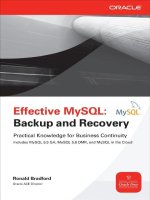IT training thenewstack book2 applications and microservices with docker and containers khotailieu
Bạn đang xem bản rút gọn của tài liệu. Xem và tải ngay bản đầy đủ của tài liệu tại đây (2.07 MB, 148 trang )
2
vol.
APPLICATIONS
& MICROSERVICES
WITH
DOCKER
& CONTAINERS
EDITED & CURATED BY ALEX WILLIAMS
The New Stack:
The Docker and Container Ecosystem eBook Series
Alex Williams, Founder & Editor-in-Chief
Benjamin Ball, Technical Editor & Producer
Hoang Dinh, Creative Director
Sam Charrington, Editor, Founder and Principal Analyst of CloudPulse
Strategies
Contributors:
Joab Jackson, Managing Editor
Judy Williams, Copy Editor
Lawrence Hecht, Data Research Director
Michelle Maher, Copy Editor
Patricia Dugan, Director of Community Marketing & Development
TABLE OF CONTENTS
Introduction .................................................................................................................................. 4
Sponsors ........................................................................................................................................ 6
APPLICATIONS & MICROSERVICES WITH DOCKER & CONTAINERS
From Monolith to Microservices ................................................................................................ 7
The Ten Commandments of Microservices ..........................................................................20
How Microservices Have Changed and Why They Matter ..................................................30
Apcera: Creating Standards for the Container Ecosystem .................................................40
Containers in Production, Part I: Case Studies .....................................................................41
Cisco: Microservices Frameworks for Handling Complexity at Scale ..............................51
The Developers and Companies Shaping the Open Source Container Ecosystem .....52
Docker: Rethinking the Development and Delivery Environments..................................72
........................................................................73
IBM: The Evolution of Architectures at Container-Scale.....................................................81
Leveraging Containers to Provide Feedback Loops for Developers ................................82
Joyent: A Historical Perspective and the Future of Containers.........................................90
How Containers and Microservices Work Together to Enable Agility ..............................91
Pivotal: What Does It Mean to Be Cloud Native? ..................................................................99
The Role of Platform-as-a-Service in the Container Era ..................................................100
VMware: Integrating Containers Allows Businesses to Move Faster..............................105
Achieving Innovation and Agility With Cloud-Native Application Architectures .........106
APPLICATIONS & MICROSERVICES DIRECTORY
Microservices Frameworks .....................................................................................................123
Provision of Capabilities for Microservices .........................................................................129
Deployment and Continuous Integration ...........................................................................139
Disclosures.................................................................................................................................147
APPLICATIONS & MICROSERVICES WITH DOCKER & CONTAINERS
3
INTRODUCTION
As an architectural pattern, microservices have been getting a lot of
attention in the last several years, reaching a level of adoption and
evangelism that would be hard for most practitioners to ignore. But while
microservices architectures have received wide praise as changing the
application development and production process on the whole, there are
name for service-oriented architecture (SOA). It’s important to explore
both the drivers that shaped how microservices evolved into the pattern
we know today, and also to understand what tools and services have
made its current popularity so widely accessible.
In this ebook, The New Stack explores the ways that container-based
microservices have impacted application development and delivery. We
learn about what containers mean to the process of creating and utilizing
microservices. Through that lens, we look at how container technology
has become so important in implementing the pattern of microservices.
Within this ebook, we explore what makes up a microservices architecture,
as well as some processes around migrating monolithic applications to
microservices. We also provide case studies for containers in production.
There is also a great deal of original research we’ve performed about the
open source container ecosystem that we are eager to share with our
broader community; this series’ focus on open source communities is a
continuing topic that we are looking to expand upon, and we welcome
feedback on what we’ve done so far.
APPLICATIONS & MICROSERVICES WITH DOCKER & CONTAINERS
4
INTRODUCTION
ebook, “The Docker & Container Ecosystem.” Understanding the role of
containers and microservices in application development and
architecture will allow us to later address the complex topics ahead in our
next ebook, “Automation & Orchestration with Docker & Containers,”
where we’ll cover orchestration, service discovery, schedulers, cluster
distributed systems.
This ebook, as well as the three to come in this series, breaks down our
analysis of the ecosystem into areas of focus that need the added depth
of an entire book. We discovered early on that there’s much more to say
about the container ecosystem, and this series is likely just the start for us.
We’re constantly looking for new topics in need of greater focus and
education, and we welcome any feedback on what areas we should tackle
next.
Thanks so much for your interest in our ebook series. Please reach out to
our team any time with feedback, thoughts, and ideas for the future.
Thanks,
Ben
Benjamin Ball
Technical Editor and Producer
The New Stack
APPLICATIONS & MICROSERVICES WITH DOCKER & CONTAINERS
5
SPONSORS
We are grateful for the support of the following ebook series sponsors:
And the following sponsors for this ebook:
APPLICATIONS & MICROSERVICES WITH DOCKER & CONTAINERS
6
FROM MONOLITH TO
MICROSERVICES
by VIVEK JUNEJA
M
manage complex enterprise systems. It is a delicate balancing
act, one that rests on understanding how any one change will
system’s codebase before they can even begin to work on it. Even the
most knowledgeable of development teams is fearful of making changes
or adding new code that would disrupt operation in some unforeseen
way, so the most mundane of changes is discussed ad nauseum.
When things go wrong, operations blames development and development
blames QA. Project managers blame the budget and everyone else. The
replace the internal team.
Unless you’ve been living under a rock, you’ve heard of how microservices
can turn this scenario on its head, enabling a new, more agile world in
which developers and operations teams work hand in hand to deliver
APPLICATIONS & MICROSERVICES WITH DOCKER & CONTAINERS
7
FROM MONOLITH TO MICROSERVICES
single monolithic system, functionality is carried out by a smaller set of
services coordinating their operations.
How do you make it work? You’ve come to the right place. We’ll explain it
exist, it is helpful to examine the base principles that have guided
Adopting Microservices
One common approach for teams adopting microservices is to identify
existing functionality in the monolithic system that is both non-critical
and fairly loosely coupled with the rest of the application. For example, in
for a microservices proof-of-concept. Alternately, more sophisticated
teams can simply mandate that all new functionality must be developed
as a microservice.
In each of these scenarios, the key challenge is to design and develop the
integration between the existing system and the new microservices. When
a part of the system is redesigned using microservices, a common
practice is to introduce glue code to help it to talk to the new services.
An API gateway can help combine many individual service calls into one
coarse-grained service, and in so doing reduce the cost of integrating with
the monolithic system.
The main idea is to slowly replace functionality in the system with discrete
microservices, while minimizing the changes that must be added to the
system itself to support this transition. This is important in order to reduce
APPLICATIONS & MICROSERVICES WITH DOCKER & CONTAINERS
8
FROM MONOLITH TO MICROSERVICES
the cost of maintaining the system and minimize the impact of the
migration.
Microservices Architectural Patterns
A number of architectural patterns exist that can be leveraged to build a
solid microservices implementation strategy.
In their book “The Art of Scalability,” Martin Abbott and Michael Fisher
elaborated on the concept of the “scale cube,” illustrating various ways to
think about the use of microservices to more easily scale systems (Figure
1). The microservices pattern maps to the Y-axis of the cube, wherein
functional decomposition is used to scale the system. Each service can
then be further scaled by cloning (X-axis) or sharding (Z-axis).
Alistair Cockburn introduced the “ports and adapters” pattern, also called
hexagonal architecture, in the context of building applications that can be
tested in isolation. However, it has been increasingly used for building
reusable microservices-based systems, as advocated by James Gardner
and Vlad Mettler. A hexagonal architecture is an implementation of a
pattern called bounded context, wherein the capabilities related to a
Examples abound of these principles being put to practice by enterprises
migrating to microservices. Click Travel open sourced their Cheddar
framework, which captures these ideas in an easy-to-use project template
for Java developers building applications for Amazon Web Services.
application, based their microservices migration on the use of the
APPLICATIONS & MICROSERVICES WITH DOCKER & CONTAINERS
9
The Scale Cube and Microservices: 3 Dimensions to Scaling
FROM MONOLITH TO MICROSERVICES
Maximum scalability
Scale by Using Microservices
Y-Axis (functional decomposition)
Scale by Sharding Databases
Z-Axis (data partitioning)
Monolithic system
Scale by Cloning Services
X-Axis (horizontal duplication)
/>
FIG 1: Illustrating Martin Abbott and Michael Fisher’s “scale cube” method of scaling
systems with functional decomposition.
bounded context pattern to identify cohesive feature sets which did not
couple with the rest of domain.
One challenge faced by teams new to microservices is dealing with
distributed transactions spanning multiple independent services. In a
monolith this is easy, since state changes are typically persisted to a
common data model shared by all parts of the application. This is not the
case, however, with microservices. Having each microservice managing its
own state and data introduces architectural and operational complexity
when handling distributed transactions. Good design practices, such as
domain-driven design, help mitigate some of this complexity by inherently
limiting shared state.
APPLICATIONS & MICROSERVICES WITH DOCKER & CONTAINERS
10
FROM MONOLITH TO MICROSERVICES
Event-oriented patterns such as event sourcing
responsibility segregation (CQRS) can help teams ensure data consistency
in a distributed microservices environment. With event sourcing and
CQRS, the state changes needed to support distributed transactions can
be propagated as events (event sourcing) or commands (CQRS). Each
microservice that participates in a given transaction can then subscribe to
the appropriate event.
This pattern can be extended to support compensating operations by the
microservice when dealing with eventual consistency. Chris Richardson
presented an implementation of this in his talk at hack.summit() 2014 and
shared example code via GitHub. Also worth exploring is Fred George’s
notion of “streams and rapids,” which uses asynchronous services and a
high speed messaging bus to connect the microservices in an application.
While these architectures are promising, it is important to remember that,
during the transition from monolith to a collection of microservices, both
systems will exist in parallel. To reduce the development and operational
costs of the migration, the patterns employed by the microservices must
be appropriate to the monolith’s architecture.
Architectural & Implementation
Considerations
Domain Modeling
Domain modeling is at the heart of designing coherent and loosely
coupled microservices. The goal is to ensure that each of your
microservices in the system.
APPLICATIONS & MICROSERVICES WITH DOCKER & CONTAINERS
11
Scaling With Microservices
FROM MONOLITH TO MICROSERVICES
Microservice architectures have 3 dimensions of scalability
1. Functional Decomposition
Y-Axis Scaling
3. Horizontal Scaling of Individual Services
X-Axis Scaling
2. Data Partitioning
Z-Axis Scaling
Monolith
Microservices
h t t p : / / m a r t i n fo w l e r. c o m / a r t i c l e s / m i c ro s e r v i c e s. h t m l
FIG 2: With microservices in place as a foundation, additional levels of scalability can
be achieved via data partitioning and horizontal scaling.
Isolating and insulating microservices also helps ensure their reusability.
For example, consider a promotions service that can be extracted from a
monolithic e-commerce system. This service could be used by various
consuming clients using mobile Web, iOS or Android apps. In order for this
to work predictably, the domain of “promotions,” including its state
entities and logic, needs to be insulated from other domains in the
system, like “products,” “customers,” “orders,” etc. This means the
promotions service must not be polluted with cross-domain logic or
entities.
Proper domain modeling also helps avoid the pitfall of modeling the
system along technological or organizational boundaries, resulting in data
APPLICATIONS & MICROSERVICES WITH DOCKER & CONTAINERS
12
FROM MONOLITH TO MICROSERVICES
services, business logic and presentation logic each implemented as
separate services.
“
All roads to microservices pass
through domain modeling.
Sam Newman discusses these principles in his book “Building
Microservices.” Vaughn Vernon focuses on this area even more deeply in
“Implementing Domain-Driven Design.”
Service Size
Service size is a widely debated and confusing topic in the microservices
community. The overarching goal when determining the right size for a
microservice is to not make a monolith out of it.
The “Single Responsibility Principle” is a driving force when considering
the right service size in a microservices system. Some practitioners
advocate as small a service size as possible for independent operation
and testing. Building microservices in the spirit of Unix utilities also leads
to small codebases which are easy to maintain and upgrade.
Architects must be particularly careful in architecting large domains, like
“products” in an e-commerce system, as these are potential monoliths,
of products, for example. For each type of product, there could be
Encapsulating all this can become overwhelming, but the way to
approach it is to put more boundaries inside the product domain and
create further services.
APPLICATIONS & MICROSERVICES WITH DOCKER & CONTAINERS
13
FROM MONOLITH TO MICROSERVICES
Another consideration is the idea of replaceability. If the time it takes to
replace a particular microservice with a new implementation or
technology is too long (relative to the cycle time of the project), then it’s
Testing
Let’s look at some operational aspects of having the monolithic system
progressively transformed into a microservices-based system. Testability
is a common issue: during the course of developing the microservices,
teams will need to perform integration testing of the services with the
monolithic system. The idea, of course, is to ensure that the business
operations spanning the pre-existing monolithic system and the new
microservices do not fail.
One option here is to have the system provide some consumer-driven
contracts that can be translated into test cases for the new
microservices. This approach helps ensure that the microservice always
has access to the expectations of the system in the form of automated
tests. The system’s developers would provide a spec containing sample
to create relevant mocks, and as the basis for an automated test suite
that is run before integrating the new microservices with the existing
system. Pact, a consumer-driven contract testing library, is a good
reference for this approach.
Creating a reusable test environment that can deploy a test copy of the
for those teams and improves the feedback loop for the project as a
whole. A common way of accomplishing this is to containerize the entire
APPLICATIONS & MICROSERVICES WITH DOCKER & CONTAINERS
14
FROM MONOLITH TO MICROSERVICES
monolith in the form of Docker containers orchestrated through an
automation tool like Docker Compose. This deploys a test infrastructure
integration tests locally.
Service Discovery
A service may need to know about other services when accomplishing a
business function. A service discovery system enables this, wherein each
service refers to an external registry holding the endpoints of the other
services. This can be implemented through environment variables when
dealing with a small number of services; etcd, Consul and Apache
ZooKeeper are examples of more sophisticated systems commonly used
for service discovery.
Deployment
Each microservice should be self-deployable, either on a runtime
container or by embedding a container in itself. For example, a JVM-based
microservice could embed a Tomcat container in itself, reducing the need
for a standalone web application server.
At any point in time, there could be a number of microservices of the
same type (i.e., X-axis scaling as per the scale cube) to allow for more
. This implementation allows for failover and transparent
Build and Release Pipeline
common, such as having a continuous integration and deployment
APPLICATIONS & MICROSERVICES WITH DOCKER & CONTAINERS
15
FROM MONOLITH TO MICROSERVICES
pipeline. The notable caveat for this in a microservices-based system is
having an on-demand, exclusive, build and release pipeline for each
microservice. This reduces the cost of building and releasing the
application as a whole.
“
We do not need to build the
monolith when a microservice gets
updated. Instead, we only build the
changed microservice and release it
to the end system.
Release practices also need to include the concept of rolling upgrades or
blue-green deployment. This means that, at any point of time in a new
build and release cycle, there can be concurrent versions of the same
microservice running in the production environment. A percentage of the
active user load can be routed to the new microservice version to test its
operation, before slowly phasing out the old version. This helps to ensure
that a failed change in a microservice does not cripple the monolith. In
case of failure, the active load can be routed back to the old version of the
same service.
Feature Flags
One other common pattern is to allow for
us to trigger the use of the relevant microservice for the feature when the
APPLICATIONS & MICROSERVICES WITH DOCKER & CONTAINERS
16
FROM MONOLITH TO MICROSERVICES
the monolith to microservices.
If the monolith version of a feature and the new microservice replicating
teams more rapidly build the end system.
Developer Productivity During
Microservices Adoption
still small. However, this becomes a development and operations
nightmare as the system grows up.
“
If working with your monolith was
always as painful as it is now, you
probably wouldn’t have it. Rather,
systems become monoliths because
adding onto the monolith is easy at
when building a new feature or system is complicated and has many
moving parts. Doing so demands strong disciplines around architecture
and automation, which in turn helps create an environment that allows
APPLICATIONS & MICROSERVICES WITH DOCKER & CONTAINERS
17
FROM MONOLITH TO MICROSERVICES
One approach to building out this developer infrastructure is to create a
standard boilerplate project that encapsulates key principles of
microservice design, including project structure, test automation,
integration with instrumentation and monitoring infrastructures, patterns
like circuit breakers and timeouts, API frameworks, and documentation
hooks, among others.
and more on building business functionality in a distributed microservicesbased environment. Projects like Dropwizard, Spring Boot, and Karyon are
interesting approaches to solving this. Making the right choice between
them depends on the architecture and developer skill level.
Monitoring and Operations
monitoring of performance, systems and resources. This is more
pronounced if a particular feature from the monolith is replicated through
a microservice. Collecting statistics for performance and load will allow
the monolithic implementation and the microservices-based one
replacing it to be compared. This will enable better visibility into the gains
that the new implementation brings to the system, and improve
Organizational Considerations
The most challenging aspects of moving from monoliths to microservices
multidisciplinary units which include developers, testers and operations
APPLICATIONS & MICROSERVICES WITH DOCKER & CONTAINERS
18
FROM MONOLITH TO MICROSERVICES
Conclusion
Most of the ideas shared in this article have either been practiced or have
delivered results in organizations of all sizes. However, this is not a
evolving patterns and adoption war stories. As more organizations move
from monolithic systems to microservices, we will have more to learn
along our journey.
APPLICATIONS & MICROSERVICES WITH DOCKER & CONTAINERS
19
THE TEN
COMMANDMENTS OF
MICROSERVICES
by JANAKIRAM MSV
S
computing model, componentization with component object
multitier architecture with .NET and Enterprise JavaBeans (EJB), and more
recently, web-scale computing.
Microservices 101
With Infrastructure as a Service (IaaS), it is fascinating to implement the
concept of scale-out and elasticity on cloud platforms. DevOps can create
dependencies and code. As long as the application servers and web
servers are stateless, they can scale from a handful of instances to a few
either get launched or terminated without much intervention.
APPLICATIONS & MICROSERVICES WITH DOCKER & CONTAINERS
20
THE TEN COMMANDMENTS OF MICROSERVICES
This architecture addressed the complex challenge of capacity planning.
underutilization or overprovisioning of resources. Cloud infrastructure
made the virtual machine the unit of deployment and execution. An
application’s scalability factor depended on the ability to rapidly multiply
virtual machines (VMs). Though the VM was an ideal choice for the unit of
deployment, the unit of code continued to be a module or a component.
It was overkill to create a one-to-one mapping between the component
and the VM.
With the emergence of containers, the unit of deployment gradually
technologies, such as LXC, Docker, runC and rkt, make it possible to run
multiple containers within the same VM. This enables DevOps to package
each component or module as a container. Each container has
component needs to run as a standalone unit. Like stateless components,
containers can be designed to accept input and send output, if any.
The composition of these containers can logically form an application.
The focus of an application becomes orchestrating multiple containers to
achieve the desired output.
“
A collection of independent,
autonomous containers participating
microservices architecture.
APPLICATIONS & MICROSERVICES WITH DOCKER & CONTAINERS
21
THE TEN COMMANDMENTS OF MICROSERVICES
This design relies more on containers and less on the underlying
infrastructure, such as VMs or physical servers. Since the unit of
deployment is a container, there can be more containers per VM or
physical server.
Microservices architecture has its roots in proven distributed computing
models like COM, CORBA and EJB. Best practices from these
technologies are still relevant in the microservices era. Some think of
microservices as service-oriented architecture (SOA) with an emphasis
on small ephemeral components.
Containers and Microservices
There is a misconception that moving a monolithic application to
containers automatically turns it into a microservice. The best way to
understand this concept is to think of virtualization and cloud. During the
initial days of IaaS, many CIOs claimed they were running a private cloud;
but, in reality, they were only implementing virtualization. Commonly,
attributes like self-service, elasticity, programmability and pay-by-use
While microservices may use containerization, not every containerized
application is a microservice. This is an important aspect to understand
before we proceed to discuss best practices.
1. Clean Separation of Stateless and
Stateful Services
Applications composed of microservices contain both stateless and
stateful services. It is important to understand the constraints and
APPLICATIONS & MICROSERVICES WITH DOCKER & CONTAINERS
22
THE TEN COMMANDMENTS OF MICROSERVICES
limitations of implementing stateful services. If a service relies on the
state, it should be separated into a dedicated container that’s easily
accessible.
One of the key advantages of microservices is the ability to scale rapidly.
Like other distributed computing architectures, microservices scale better
when they are stateless. Within seconds, multiple containers can be
launched across multiple hosts. Each container running the service is
autonomous and doesn’t acknowledge the presence of other services.
scaling the VMs. For this pattern to work seamlessly, services should be
stateless. Containers are ephemeral and thus become an ideal choice for
microservices.
A microservices-based application may contain stateful services in the
form of a relational database management system (RDBMS), NoSQL
Technologies, such as Flocker and Docker volume plugins, address this
problem by creating a separate persistence layer that’s not
host-dependent.
available cloud data stores to provide a persistence layer. Both
data stores trade consistency for availability, meaning that we have to
design for eventual consistency in our data model.
APPLICATIONS & MICROSERVICES WITH DOCKER & CONTAINERS
23
THE TEN COMMANDMENTS OF MICROSERVICES
Technologies, such as Flocker, help address the host portability problem
by creating a persistence layer that’s not host dependent. The new cloud
datastores, such as Redis, Cassandra, and IBM’s Cloudant, maximize
availability with minimal delay on consistency. As container technologies
evolve, it will become easier to tackle the stateful services problem.
2. Do Not Share Libraries or SDKs
units of code that do one thing and one thing only. This is closely aligned
with the principle of “don’t repeat yourself” (DRY), which states that every
piece of knowledge must have a single, unambiguous, authoritative
representation within a system.
Every service is a self-contained unit of OS, runtime, framework, thirdparty libraries and code. When one or more containers rely on the same
library, it may be tempting to share the dependencies by centrally
pipeline. Upgrading the library or SDK might end up breaking a service.
Each service should be treated entirely independent of others.
In some scenarios, the commonly used libraries and SDKs can be moved
to a dedicated service that can be managed independently, making the
service immutable.
assumptions can be made about the host on which the service would run.
APPLICATIONS & MICROSERVICES WITH DOCKER & CONTAINERS
24
THE TEN COMMANDMENTS OF MICROSERVICES
Each service can be launched on any available host in the cluster that
function independently of the host on which they are deployed.
In case of stateful services, a dedicated persistent (data volume) container
should be considered.
4. Focus on Services with One Task in
Mind
Each service must be designed with one task in mind. It may map to one
may also be one process per container, but that’s not always the case.
from virtual machines. While a virtual machine may run the whole stack, a
container owns a subset of the stack. For example, when refactoring a
LAMP web application for microservices, the web tier with Apache runs in
a dedicated container while MySQL moves to another container.
5. Use Lightweight Messaging Protocol
for Communication
There is no hard-and-fast rule on how microservices talk to each other.
They can use synchronous or asynchronous channels with any protocol
APPLICATIONS & MICROSERVICES WITH DOCKER & CONTAINERS
25









